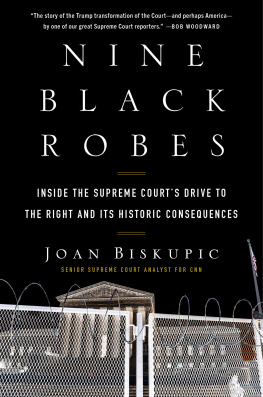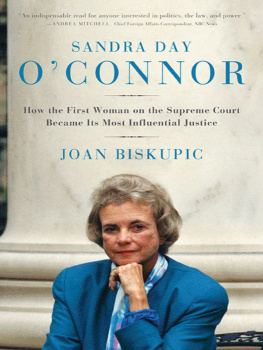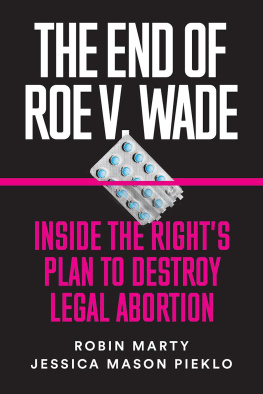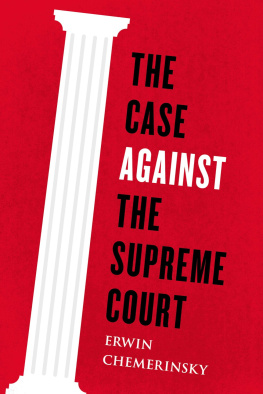Annotation
**CNN Senior Supreme Court Analyst Joan Biskupic provides an urgent and inside look at the history-making era in the Supreme Court during the Trump and post-Trump years, from its seismic shift to the Right to its controversial decisions, including its reversal of Roe v. Wade, based on access to all the key players.**Nine Black Robes displays the inner maneuverings among the Supreme Court justices that led to the seismic reversal of Roe v. Wade and a half century of women's abortion rights. Biskupic details how rights are stripped away or, alternatively as in the case of gun owners, how rights are expanded. Today's bench--with its conservative majority--is desperately ideological. The Court has been headed rightward and ensnared by its own intrigues for years, but the Trump appointments hastened the modern transformation. With unparalleled access to key players, Biskupic shows the tactics of each justice and reveals switched votes and internal pacts...
Dedication
For Clay and Elizabeth
Epigraph
No one should be confident that this majority is done with its work.
Dobbs v. Jackson Women's Health Organization,
dissenting justices, June 24, 2022
Contents
Cover
Title Page
Dedication
Epigraph
Authors Note
Prologue: Unmasked
Chapter 1: Inside the Castle
Chapter 2: Nobody on That Court Is like Anybody Else on That Court
Chapter 3: Joining Us for Tonights Ceremony Is Every Sitting Supreme Court Justice
Chapter 4: The Triumvirate
Chapter 5: A Moment of Truth
Chapter 6: Justice Is Not Inevitable
Chapter 7: Culture Wars in a Time of COVID
Chapter 8: The Chief at the Height of His Power
Chapter 9: A Deathbed Wish
Chapter 10: Bush v. Gore and Trump v. Biden
Chapter 11: The Supermajority
Chapter 12: Zero. None.
Epilogue
Acknowledgments
Notes
Index
About the Author
Also by Joan Biskupic
Copyright
About the Publisher
Authors Note
This book is a group portrait of the Supreme Court during a historic period in American law influenced by the presidency of Donald Trump and its aftermath. The Court overturned nearly a half century of abortion rights, obliterated protections of the 1965 Voting Rights Act (VRA), curtailed government regulatory power, and blurred the separation of church and state. The transformed Court was decades in the making, but its character was solidified by the three appointees of former president Trump. From his campaign of 2016 into the early years of the Joe Biden administration, tensions within the Court spiraled. The justices maneuvered uneasily around each other. Two deaths marked this periodAntonin Scalias in 2016 and Ruth Bader Ginsburgs in 2020as did the COVID-19 pandemic.
I have relied on the records of cases, archives, and more than a hundred interviews with people on the Court and in its orbit, including a majority of the justices. This book also builds on my daily journalistic coverage of the Court and my four previous works on individual justices, including a biography of Scalia, the model for the Trump justices, and a biography of Chief Justice John Roberts, who recalibrated his leadership and his approach to the law with each addition to the bench.
Seven men and five women served in the years covered in this book: Roberts, appointed by George W. Bush in 2005; Anthony Kennedy, put on the bench by Ronald Reagan in 1988; Clarence Thomas, by George H. W. Bush in 1991; Ruth Bader Ginsburg, by Bill Clinton in 1993; Stephen Breyer, by Clinton in 1994; Samuel Alito, by George W. Bush in 2006; Sonia Sotomayor, by Barack Obama in 2009; Elena Kagan, by Obama in 2010; the three Trump appointees, Neil Gorsuch, 2017, Brett Kavanaugh, 2018, Amy Coney Barrett, 2020; and Ketanji Brown Jackson, selected by Biden in 2022 as the first Black woman justice, a groundbreaking appointment to a Court that has been, paradoxically, going backward.
Prologue
Unmasked
The lectern where the lawyers stood to argue their cases had been pushed back twenty feet from the Supreme Courts elevated bench. Dozens of wooden chairs that normally filled the front section of the courtroom were gone. The tableau on this November 1, 2021, morning was spare, as the coronavirus pandemic still raged and extra health precautions were in place. For the few spectators permitted to attend the suspenseful Texas abortion arguments, all wearing high-grade, tight-fitting masks and sitting well spaced on the red upholstered seats, the view of the nine justices was direct and unobstructed.
The Court had scheduled the morning hearing after letting a Texas abortion ban take effect in a midnight order on September 1. For two months, women in Americas second-most-populous state had been living without the right to abortion. The Supreme Court had guaranteed that right in its 1973 Roe v. Wade milestone and reaffirmed it many times, most definitively in 1992s Planned Parenthood of Southeastern Pennsylvania v. Casey. The Texas legislature had flouted those precedents and the Constitution and prohibited abortion after the first sign of fetal cardiac activity, roughly six weeks, a point when many women do not yet know they are pregnant and a point, too, at which fetal heart valves have not developed, making heartbeat law a misnomer.1 So far, the Supreme Court had gone along with Texas and had rejected requests to suspend the ban until its validity could be assessed. The justices action in the case illuminated how much the Court had changed and no longer could be counted on to protect certain individual rights.2
Pregnant women who wanted an abortion were traveling to Oklahoma and other nearby states. Those without the money to leave Texas were panicking, forced to end their pregnancies on their ownmany using misoprostol and other oral medicationsor to carry an unwanted pregnancy to term.3 Texas abortion clinics challenged the new law, declaring in a petition for a writ of certiorari, Texans are in crisis. The clinics implored the Supreme Court to scrutinize the unusual statute, which gave private citizens the right to sue physicians, clinic staff, or any person who helped a woman obtain an abortion.4 The Texas attorney general argued that the justices lacked jurisdiction even to hear the case because the legislature had written the law, shrewdly, in a way that let private individuals, not state officials, enforce it, thereby shielding officials from lawsuits. The statute granted a minimum of $10,000 in damages for each abortion successfully challenged. The threat of unlimited litigation and ruinous financial liability was forcing clinics to stop most abortions.
When the Supreme Court let the Texas law go forward on September 1, Chief Justice John Roberts dissented, joined by the senior liberal justice, Stephen Breyer, and Justices Sonia Sotomayor and Elena Kagan. The moment revealed a loss of control for the usually persuasive leader of the bench. Surely no proponent of abortion rights, Roberts was nonetheless astonished that a state would attempt to invalidate decisions tracing back nearly fifty years to Roe v. Wade. Only the Supreme Court itself had such power. The five conservatives who controlled that September 1 action sided with state officials, saying that the heartbeat bills challengers had failed to show that they were likely to succeed on the merits of the question or be irreparably harmed if the ban took effect during litigation. The applicants now before us have raised serious questions regarding the constitutionality of the Texas law at issue, the majority wrote in the unsigned order. But their application also presents complex and novel antecedent procedural questions on which they have not carried their burden. The majority brushed aside arguments about women awaiting immediate care, women who lacked the means to travel out of state, and women who, if delayed for even a few more weeks, would be affected by Texass separate deadlines for obtaining an abortion at all.






